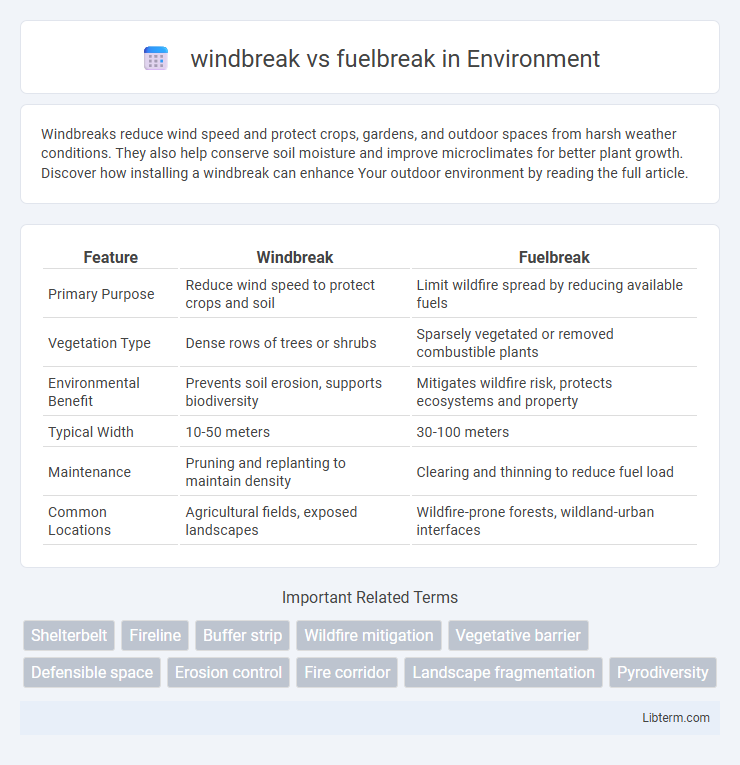Windbreaks reduce wind speed and protect crops, gardens, and outdoor spaces from harsh weather conditions. They also help conserve soil moisture and improve microclimates for better plant growth. Discover how installing a windbreak can enhance Your outdoor environment by reading the full article.
Table of Comparison
| Feature | Windbreak | Fuelbreak |
|---|---|---|
| Primary Purpose | Reduce wind speed to protect crops and soil | Limit wildfire spread by reducing available fuels |
| Vegetation Type | Dense rows of trees or shrubs | Sparsely vegetated or removed combustible plants |
| Environmental Benefit | Prevents soil erosion, supports biodiversity | Mitigates wildfire risk, protects ecosystems and property |
| Typical Width | 10-50 meters | 30-100 meters |
| Maintenance | Pruning and replanting to maintain density | Clearing and thinning to reduce fuel load |
| Common Locations | Agricultural fields, exposed landscapes | Wildfire-prone forests, wildland-urban interfaces |
Introduction to Windbreaks and Fuelbreaks
Windbreaks are rows of trees or shrubs strategically planted to reduce wind speed, prevent soil erosion, and protect crops or structures from wind damage. Fuelbreaks are cleared or thinned areas designed to slow or stop the spread of wildfires by reducing available vegetation fuel. Both serve crucial roles in land management but target different environmental challenges: windbreaks focus on wind mitigation, while fuelbreaks prioritize wildfire control.
Definition of Windbreaks
Windbreaks are rows of trees or shrubs strategically planted to reduce wind speed and protect soil, crops, and structures from erosion and damage. Unlike fuelbreaks, which are designed to reduce fire risk by removing or thinning vegetation, windbreaks primarily function to improve microclimate conditions and prevent wind-related soil erosion. Effective windbreaks enhance agricultural productivity by minimizing wind stress on plants and conserving soil moisture.
Definition of Fuelbreaks
Fuelbreaks are strategically designed strips of land cleared or modified to reduce the amount of flammable vegetation, thereby slowing the spread of wildfires. Unlike windbreaks, which primarily serve to reduce wind speed and protect crops or soil, fuelbreaks focus specifically on fire management by interrupting fuel continuity. These defensible zones enhance wildfire control efforts by creating barriers that firefighters can use to contain and suppress fires more effectively.
Primary Purposes: Windbreaks vs Fuelbreaks
Windbreaks primarily serve to reduce wind speed and protect soil, crops, and livestock from wind damage, enhancing microclimates for agricultural productivity. Fuelbreaks are designed to interrupt the continuity of combustible vegetation, thereby slowing or stopping the spread of wildfires and protecting infrastructure and natural resources. The strategic placement of windbreaks targets wind erosion control, while fuelbreaks focus on fire management and risk reduction.
Structural Differences
Windbreaks consist primarily of dense rows of trees or shrubs designed to reduce wind speed and protect soil or crops from erosion. Fuelbreaks are strategically cleared or thinned strips of vegetation intended to slow or stop the spread of wildfires by reducing available fuel. The key structural difference lies in windbreaks emphasizing continuous, living barriers for wind mitigation, while fuelbreaks focus on creating gaps and reducing biomass to interrupt fire pathways.
Ecological and Environmental Impacts
Windbreaks enhance biodiversity by providing habitats for various species and improving air quality through dust and pollutant capture, while also reducing soil erosion and moisture loss. Fuelbreaks primarily aim to slow or stop wildfires by modifying fuel loads, which can lead to temporary habitat disturbance and reduced vegetation complexity. Balancing these ecological impacts requires careful planning to maintain ecosystem health while addressing fire management objectives.
Design and Implementation Considerations
Windbreaks, typically composed of dense rows of trees or shrubs, are designed to reduce wind speed and protect soil from erosion, requiring careful species selection and spacing to balance permeability and wind reduction. Fuelbreaks involve clearing or modifying vegetation to create defensible spaces that slow wildfires, necessitating strategic placement, regular maintenance, and consideration of local fire behavior and topography. Both structures demand integration with land management plans, emphasizing ecological suitability and long-term sustainability for effective protection.
Maintenance and Long-Term Management
Windbreak maintenance involves regular pruning, pest control, and replanting to ensure tree health and effective wind reduction over time. Fuelbreak management requires ongoing removal of flammable vegetation, clearing dead materials, and monitoring soil erosion to maintain fire prevention capabilities. Long-term management of both structures demands adaptive strategies to sustain ecological balance and functional integrity under changing environmental conditions.
Cost-Effectiveness Comparison
Windbreaks generally offer a cost-effective solution by reducing wind speed and protecting crops or properties with minimal maintenance and lower installation expenses, making them suitable for agricultural and residential areas. Fuelbreaks, designed to interrupt wildfire fuel continuity, involve higher initial costs due to land clearing, vegetation removal, and ongoing maintenance, but they provide critical fire prevention benefits that can save substantial costs related to fire damage. Comparing cost-effectiveness depends on context: windbreaks deliver continuous economic and environmental benefits at lower costs, whereas fuelbreaks are strategic investments essential for wildfire risk mitigation with potentially higher upfront expenditures.
Choosing the Right Solution for Your Needs
Selecting between a windbreak and a fuelbreak depends on your primary objective, whether it's protecting against wind damage or reducing wildfire risk. Windbreaks use rows of trees or shrubs to decrease wind speed and soil erosion, ideal for agricultural and residential areas exposed to strong winds. Fuelbreaks focus on creating defensible spaces by thinning vegetation to slow fire spread, essential for wildfire-prone regions requiring fire management strategies.
windbreak Infographic

 libterm.com
libterm.com